Raising pheasants can be a perfect activity for a small farmer who also owns a piece of land. Moreover, with a little investment of time and effort, you can make good money from the sale of pheasant feathers or pheasant meat. Of course, you can always grow them just for your personal use, but if you’re thinking of monetizing them, that’s the way.
All in all, pheasants are friendly birds that are relatively easy to raise, especially if you already have some knowledge of raising other birds. They are also very beautiful, so they will certainly contribute a touch of beauty to the farm.
There are about 50 pheasant species and 16 sub-families, but all are members of the same Phasianidae family. Being classified as wild birds, the male pheasants stand out through the plumage adorned with bright colors, while the females boast long tails and much more discreet colors.
Today, we will present to you the top of the most common and beautiful pheasant species in the world.
Contents
- Golden Pheasant
- Ringnecked Pheasant
- Blue Eared Pheasant
- Green Pheasant
- Silver Pheasant
- White Eared Pheasant
- Siamese Fireback
- Reeves’s Pheasant
- Lady Amherst’s Pheasant
- Brown Eared Pheasant
- Mountain Peacock Pheasant
- Swinhoe’s Pheasant
- Mikado Pheasant
- Great Argus Pheasant
- Blood Pheasant
- Tibetan Eared Pheasant
- Copper Pheasant
- Imperial Pheasant
- Mrs. Hume’s Pheasant
- Bulwer’s Pheasant
Golden Pheasant
As the name suggests, this type of pheasant is characterized primarily by the presence of the golden crest delimited by the black outline in males. It owns the title of the world’s most beautiful pheasant and, at the same time, it is part of the top of the world’s most beautiful birds in the world.
Females do not have this crest and are generally much smaller and less colorful than males, which have colored plumage in shades of yellow, orange, black, brown, and blue. The incubation period of the egg is about 23 days, and an adult female can lay up to 45 eggs per season. Moreover, females of the golden species can reach an average weight of 2.6 lbs (1.2 kg) while males can weigh approximately 3 lbs (1.4 kg).
The golden pheasant is preferable for farmers that considering raising pheasants for meat.

Ringnecked Pheasant
The Ringnecked variety is the world’s most popular pheasant and the most hunted pheasant, especially in the United States.
The unique feature of the Ringnecked Pheasant is a white ring in the neck area, which is uninterrupted at the front.
Males have brown plumage with golden hues, while females boast reddish plumage. The female lays between 10-12 eggs and leaves the nest shortly after birth with her new chicks, which are able to fly at about 12 days of age.
The ringnecked pheasant feathers are some of the most popular due to their outstanding colors.

Blue Eared Pheasant
Blue Eared Pheasant has a dark blue-gray plumage with a velvety black crown, but this variety is distinguished primarily by its scarlet red bare facial skin. The breeding season begins in April and lasts until June, and the age of the female suitable for breeding is two. This pheasant species can grow up to 3.1 ft (96 cm) long and live 12-15 years.
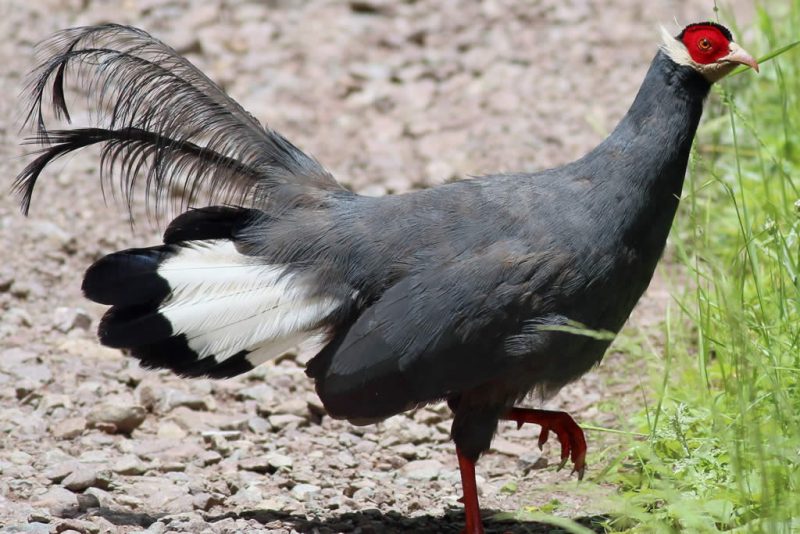
Green Pheasant
The Green pheasant is also known as the Japanese pheasant due to the fact that it is native to Japan. Its distinguishing marks are the blue-green back and chest, as well as the neck and tail, which have a purple plumage. On the other hand, the female is characterized by a reddish-brown plumage.
The green pheasant lives on average 15 years and can reach 2.6 lbs (1.2 kg) and 30-35 in (75-90 cm) long in the case of the male, and 1.9 lbs (0.9 kg) and 20-22 in (50-55 cm) long in a female.
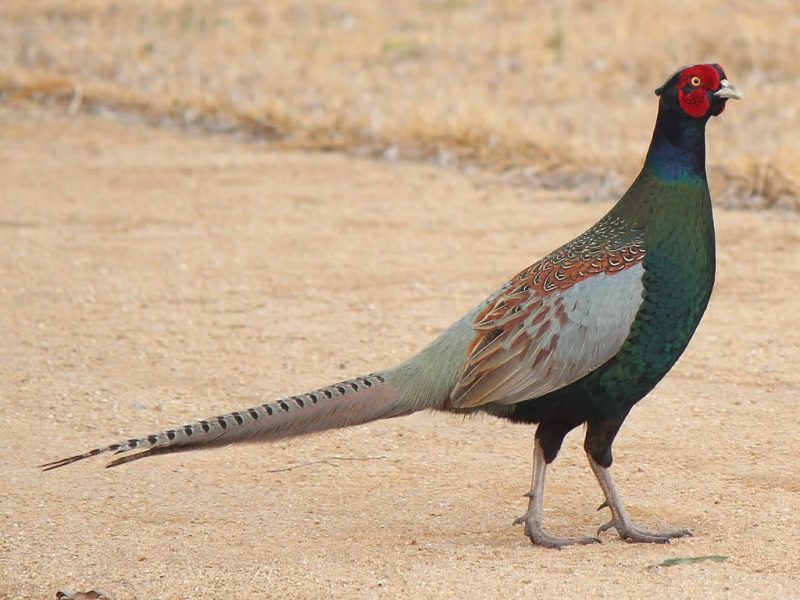
Silver Pheasant
Silver pheasants are generally found in South Asia and eastern China in forest edges with open areas.
This breed is popular due to the fact that it grows very fast and has strong immunity, becoming sick extremely rare.
Moreover, a female silver pheasant is able to lay up to 50 eggs per season. Both sexes have bare red faces and red legs, but different sizes, the female being smaller than the male.
The average body weight in males is up to 9-11 lbs (4-5 kg), while in females is around 4lbs (2 kg). The body length in males reaches up to 49 in (125 cm), of which 28 cm (70 cm) are the tails. Females are about 30 in (75 cm) long, with a tail about 12 in (30 cm) long.

White Eared Pheasant
The White Eared pheasant has predominantly white plumage, with a velvety black crown, red facial skin, and a dark tail. Founded in China, the White Eared pheasants are ready to breed in their second year. The males can reach a length of 34-38 in (86–96 cm) and 5-6 lbs (2.3-2.7 kg), while the females tend to be smaller, reaching only a weight of 3-4.5 lbs (1.4-2 kg).
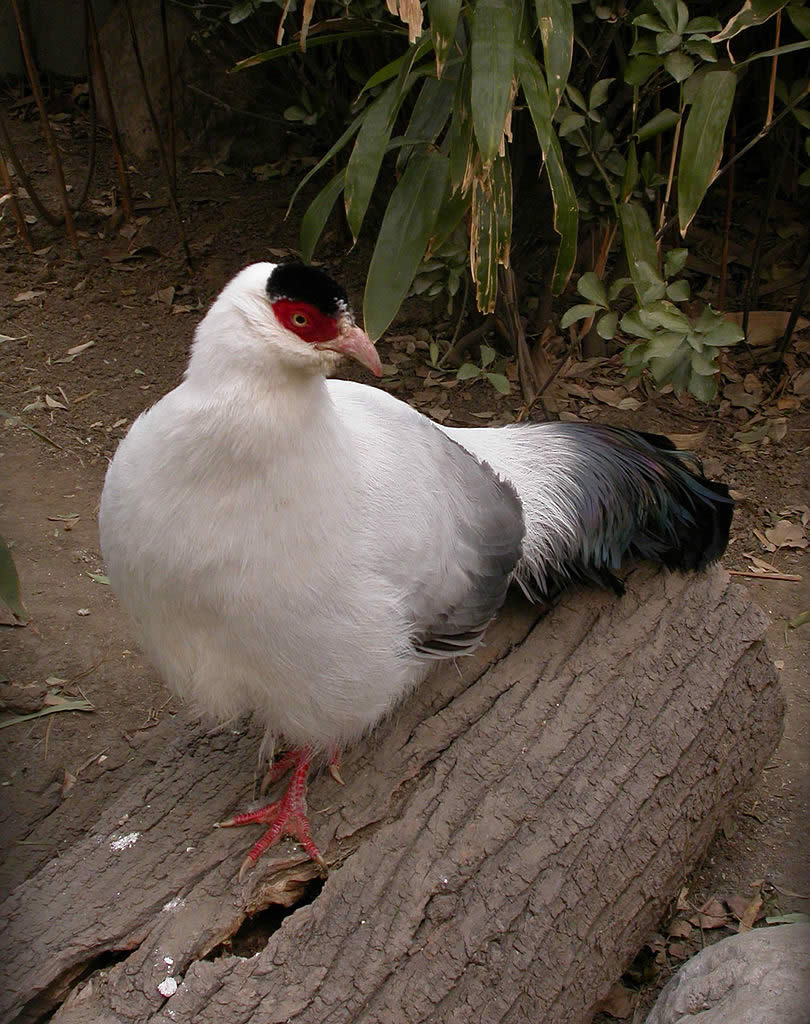
Siamese Fireback
With the scientific name given by Napoleon’s nephew, the Siamese Pheasant’s main feature is a bright yellow spot located in the middle of its back. Moreover, the male of this variety also has a long ridge of purple-black feathers, a red face, and blue, green, and white feathers, while the female has a more modest plumage.
The males can grow up to 31in (80 cm) long with a tail length of up to 14 in (36 cm), whilst the females measure 24 in (60 cm) long.
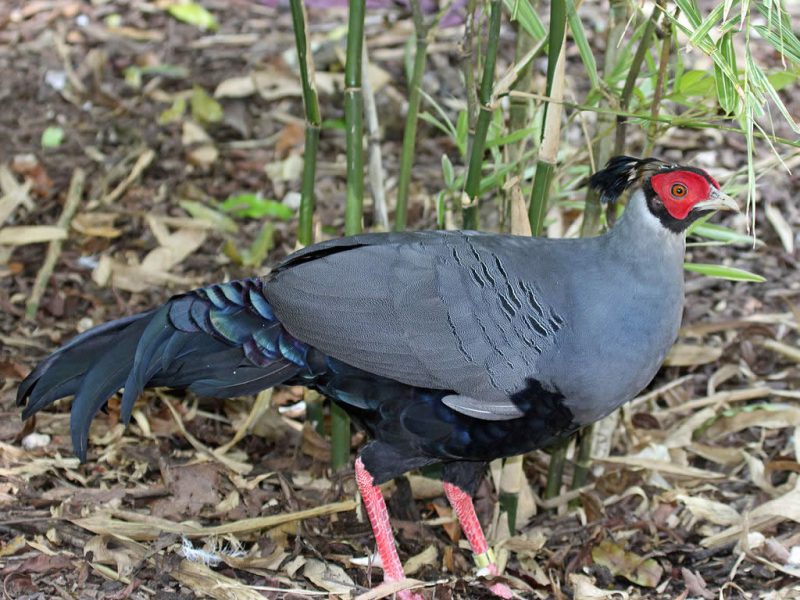
Reeves’s Pheasant
Also called the Chinese Pheasant or Mottled, Reeves’s Pheasant can boast an extremely decorative plumage with golden shades outlined in black and a thin black line on the face. Females of this variety are much smaller and less handsome than males, with only a modest reddish plumage.
These pheasants live around 14 years and can reach an average body weight of 3.5 lbs (1.6 kg) in males, and only 2.2 lbs (1 kg) in females.
Last but not least, they do not have their best reputation, being very aggressive toward other animals.

Lady Amherst’s Pheasant
The Lady Amherst’s pheasant is a terrestrial bird that prefers to live in hilly forests. This bird was named in honor of the woman who brought this type of pheasant from India to London in 1828.
The male is graceful and imposing, with shiny plumage, emerald-colored scales on his neck, and a long tail that can reach up to 1m in length. On the other hand, the females are mottled brown. Lady pheasant is very peaceful and can be raised even with other birds such as chickens or pigeons.
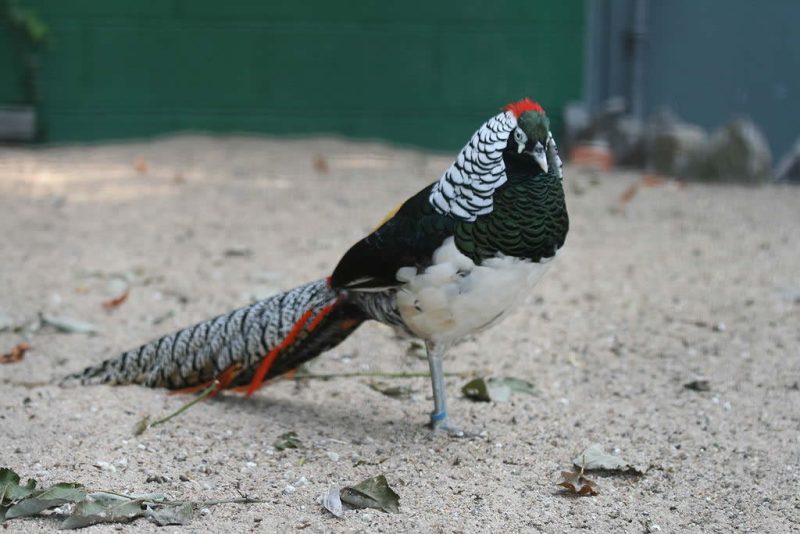
Brown Eared Pheasant
The Brown Eared pheasant is found predominantly in the mountain forests of China and is on the IUCN Red List of threatened pheasant species. This pheasant can grow up to 39 in (100 cm) long and can lay between 5-8 eggs at a time.
The main feature of this pheasant is its hair-like plumage and beautiful shiny brown color, but also the black crown, and white ears. Males and females are almost identical. The only difference is the size, as the female is generally smaller.
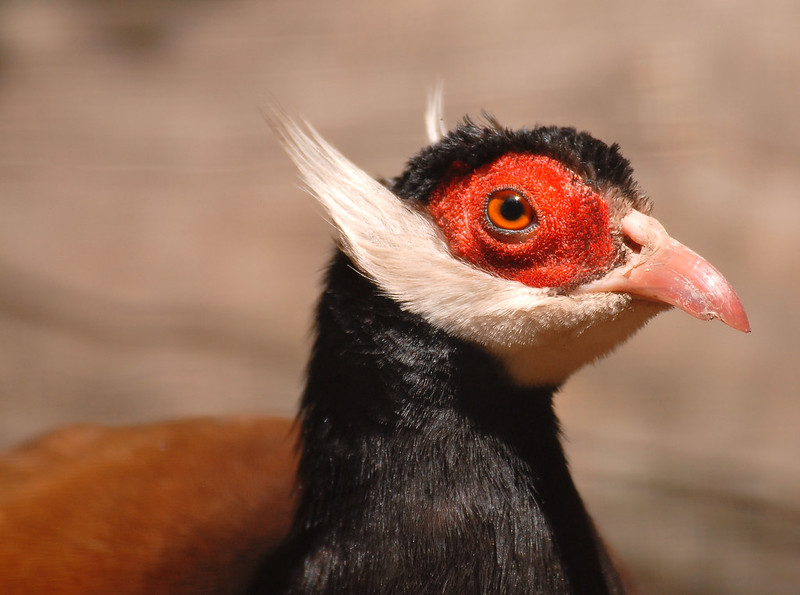
Mountain Peacock Pheasant
The Mountain Peacock or Rothschild’s Pheasant adores berries, beetles, and ants, and prefers to live in mountain forests. Their appearance is characterized by an extremely long tail, and a small, brown head. The male has bright, green spots, while the female, much smaller in size than the male, is brown.
The Mountain Peacock pheasant is evaluated as Vulnerable on the IUCN Red List of Threatened Species.

Swinhoe’s Pheasant
The Swinhoe pheasant is also called Taiwan blue pheasant and is endemic to Taiwan. The body of these male pheasants is covered with an intense blue plumage, a white back, a brown coat, and dark gray wings.
The female is much smaller than the male and has a brown color with yellow spots. The male can grow up to 31 in (79 cm) while the female is able to lay a clutch of two to six eggs, which are incubated for 25 to 28 days.
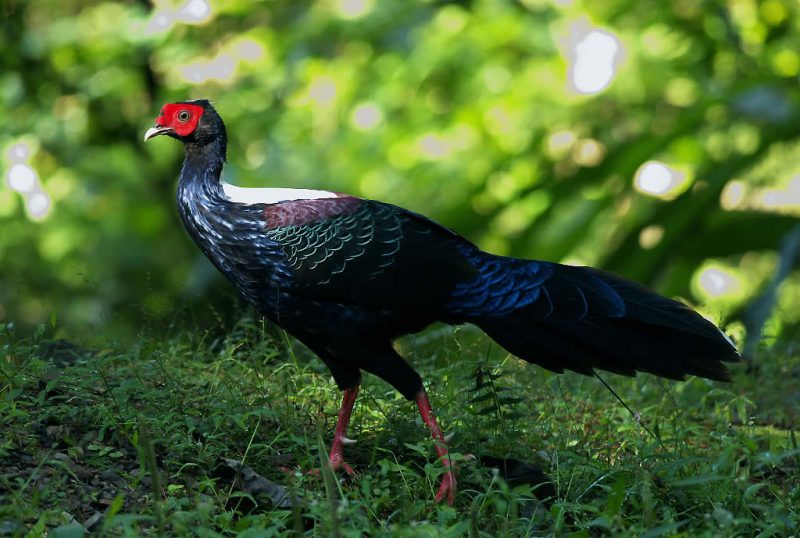
Mikado Pheasant
After the Swinhoe pheasant, the next emblematic pheasant of Taiwan is Mikado. With a lifespan of 8-10 years, the Mikado pheasant tends to be extremely territorial and always ready to fight.
Males impress with shimmering dark blue-black, with bright red holes, gray legs, and long black tails. Females are smaller and have a dull olive-brown plumage. The average adult male measures 18.5-27.5 in (47-70 cm) The average adult male measures 18.5-27.5 in (47-70 cm) and weighs an average of 1.3-2.6 lbs (600-1200 g).
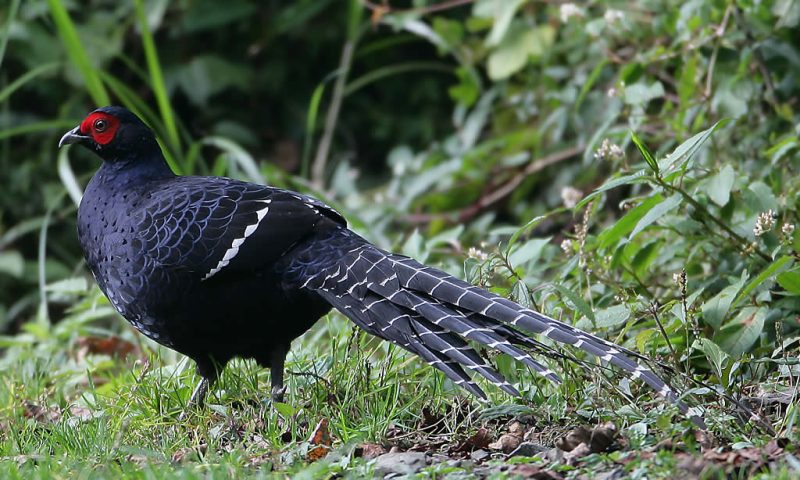
Great Argus Pheasant
The Great Argus pheasant is amongst the largest of all pheasants, reaching up to 6.5 feet (2 m) in length. Also known as Phoenix in some areas, the male pheasant Great Argus has black hair-like feathers, red legs, and beautiful wings with large eyespots. Both sexes are very similar.
Argus pheasant feathers are in great demand among enthusiasts.
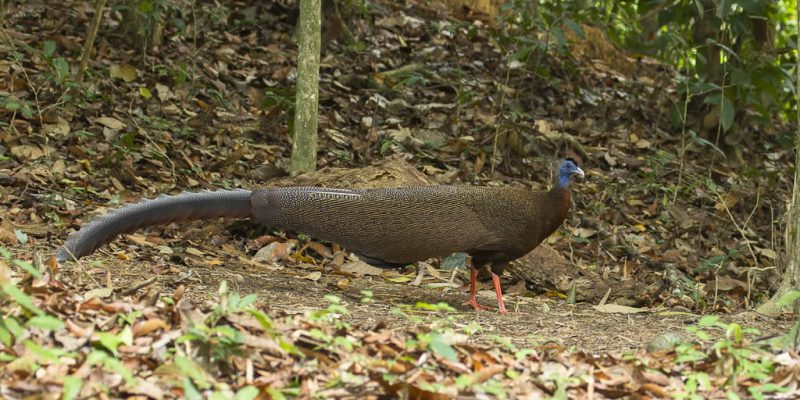
Blood Pheasant
With much smaller sizes than other varieties, the Blood pheasant can reach a length of up to 17 in (43 cm) and lives across India, Nepal, Buthan, and China.
The body is covered with silvery gray feathers and pale stripes all over the body and face. Females are warm brown with orange faces. Both sexes have a small head and an occasional raised weak crest.

Tibetan Eared Pheasant
Tibetan eared pheasant is not a bird you can see very often because it is accustomed to living in northern India at altitudes between 9,800 and 16,400 ft (3,000 and 5,000 m).
Males of this variety can grow up to 33 in (85 cm) and females are slightly smaller. The body has a reddish-brown plumage, red facial skin, and red legs.

Copper Pheasant
Copper pheasant is native to the mountainous and hilly areas of Japan, especially the islands of Honshū, Kyūshū, and Shikoku.
It is a fairly large pheasant compared to other varieties, with a length of between 34.4 – 53.5 in ( 87.4 – 136 cm) in males, while females can reach up to 21.6 in (55 cm). Copper pheasant boasts a rich coppery chestnut plumage and red facial skin.

Imperial Pheasant
The imperial pheasant is one of the rarest pheasants in the world. It was brought to Europe by Jean Théodore Delacour in 1923 and is thought to have disappeared, but was rediscovered in 1990.
The male’s body is dark blue and has bare red facial skin, a blue crest, and crimson legs. The body length of the Imperial pheasant reaches up to 29.5 in (75 cm).

Mrs. Hume’s Pheasant
Mrs. Hume’s pheasant can be found in northern Myanmar or Thailand. The appearance of this variety of pheasants is characterized by a greyish-brown head, red facial skin, chestnut-brown plumage, and metallic blue neck feathers. On the other side, females are much smaller and have chestnut brown plumage, and they can lay 3 to 12 eggs.

Bulwer’s Pheasant
The Bulwer’s pheasant is a Southeast Asian bird and has as a distinctive feature a large whitetail, glossy black plumage, and bright blue facial skin. The body length of males reaches up to 31.4 in (80 cm), while females are about 21.6 (55 cm).
Currently listed as Vulnerable by the IUCN, the Bulwer’s pheasant is also called the white-tailed wattled pheasant.

In conclusion, you can choose and purchase any pheasant species from our list if you’re thinking of raising pheasants in your household. You can start small and expand later if you really enjoy these birds and taking care of them.
Are you already involved in a pheasant business? Then leave us a comment and tell us about your experience with raising pheasants.

